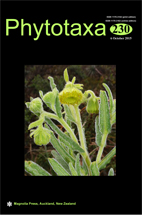Abstract
Solidago ×niederederi Khek (1905: 22) (Asteraceae) was described by Khek (1905) as a natural hybrid between S. canadensis Linnaeus (1753: 878) and S. virgaurea Linnaeus (1753: 880). The hybrid was discovered by Niedereder in the area of Stoder (Austria) in the beginning of the twentieth century. It is morphologically more or less intermediate between the presumed parents, especially in characters such as capitula size, leaf shape and venation (Khek 1905, Nilsson 1976, Karpavičienė & Radušienė 2015). Moreover, it is characterized by reduced pollen viability, and produces only very few well-developed achenes (Nilsson 1976, Migdałek et al. 2014, Karpavičienė & Radušienė 2015). According to the protologue (Khek 1905) the pappus is absent in the hybrid (“Pappus fehlend”), however, I noticed the pappus in all examined generative specimens of the hybrid from Poland. The parental species of S. ×niederederi belong to different taxonomical sections: S. canadensis is a member of S. sect. Unilaterales Don in Loudon (1830: 348), and S. virgaurea is a member of S. sect. Solidago Linnaeus (1753: 878) (Nesom 1993). The hybrid has been reported from several countries in Europe: Austria, the United Kingdom, Denmark, Sweden, Norway, Germany, Poland, Lithuania, and Russia (Nilsson 1976, Burton 1980, Sunding 1989, Mayorov et al. 2012, Pliszko 2013 and literature cited therein, Karpavičienė & Radušienė 2015). It is usually found in anthropogenic habitats together with both parental species, and its presence emphasizes the invasive character of S. canadensis (Pliszko 2013).

